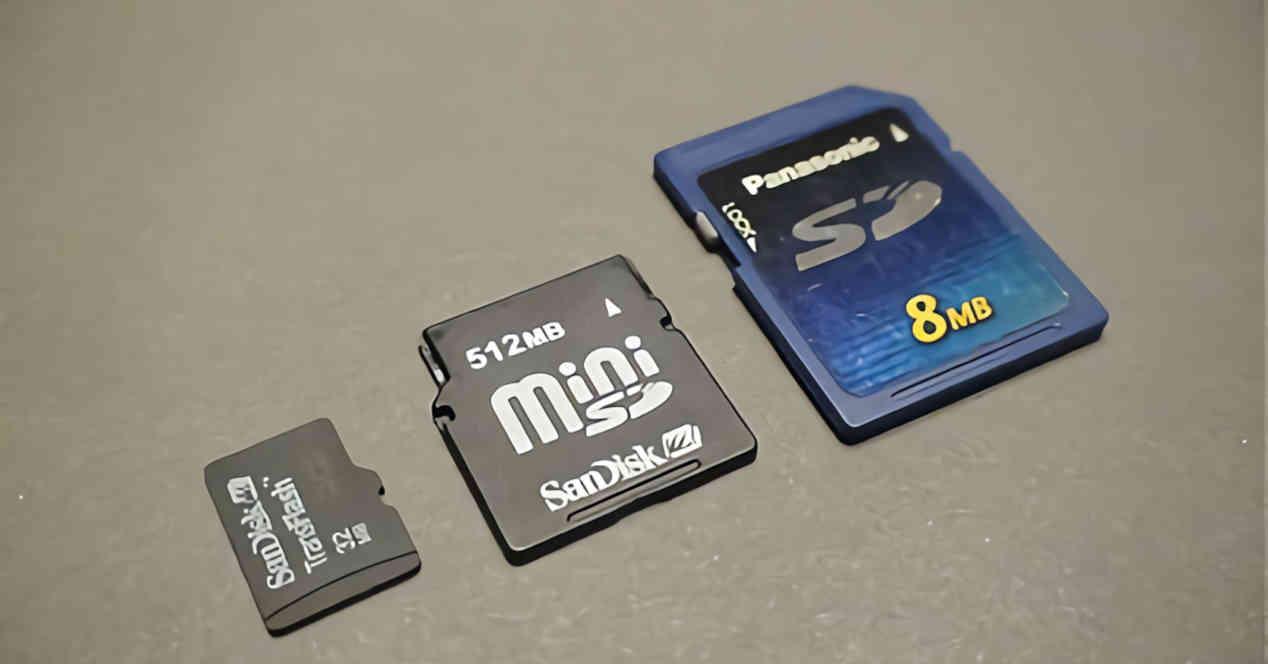A MicroSD is the most widely used type of memory card today, stores have been filled with them in packs with an adapter that allows them to be used in a standard SD card reader. If we add to this that they are used in mobile phones to expand their capacity, then we are faced with what has caused classic SD cards and even more so MiniSD to completely disappear from the card.
However, they have been with us for so long and surely more than one reader has an SD card in a drawer, inside a digital camera or a smartphone from a few years ago. By observing them, you will have seen how in many of them abbreviations appear on their label which do not appear in the rest. Acronyms such as SD, SDHC, SDXC or SDUC refer to different capacities and speeds of SD cards of different types.
The different types of SD cards that exist
It is a type of memory card that comes in three different versions in terms of size, but other than that the capacities do not vary from one type of size to another, that is why currently and as we explained in the introduction, this has made MicroSD the current standard.
- SOUTH DAKOTA: its size is 32 x 24 x 2.1 mm.
- MiniSD: we no longer see them in stores, their size is 21.5 x 20 x 1.4 mm
- MicroSD: the most common today, with the following dimensions: 15 x 11 x 1 mm
However, it is wrong to talk about these types of cards, since the standard for this type of memory cards is currently version 8.0 and has seen several improvements over time in terms of capacity and bandwidth. To say that a MicroSDXC is a MicroSD is like saying the same thing about an NVMe SSD running PCI Express 3.0 and another running Gen 4. The interface and even the form may be the same, but the performance is different.
That’s why we’re going to take a trip through the different generations of MicroSD cards until we get to the present so you can see how they’ve evolved and think twice before using an old SD card. this guy in your newest smartphone. Or you’re just wondering how come the memory card you just put in doesn’t work with that device from a few years ago that you recently saved.
SD, SDHC, SDXC, SDUC and SDIO, what does that mean?
These are different generations of SD cards that have appeared since the year 2000 until today, in short, the differences between them are as follows:
- South Dakota: the first card of all, uses the system of FAT32 files and because of that, he can’t pass from the 2 GB of storageare currently withdrawn from the market.
- SDHC; They have abilities ranging from 2 GB to 32 GB, also out of the current market due to its low storage capacity. He was the first to use the exFAT files.
- SDXC: the most widely used today, since it can reach up to 2 TB of storage.
- SDUC: If 2 TB of capacity seems insufficient, you have the choice between SDUCs of up to 128 TB . They are rare and expensive at the moment, but will replace the SDXC when the time comes.
Next we have a category called SDIOwhich are not storage cards, but rather function as interface for peripherals. In this way we can add Bluetooth module, WiFi, GPS. They are not at all common in home computing, but they are widely used in robotics, especially to integrate communication and positioning in robots.
Classes and speeds of SD, MiniSD and MicroSD cards
Another thing you will have noticed is that apart from the type of MicroSD, which indicates its generation, it is the so-called Speed Class, which is marked on each of the cards. Well, if it’s not a UHS speed class, the number tells us how many megabytes per second of sequential writes we can achieve. For class 10 we need a MicroSDHC card, which requires a slightly more powerful interface than the classic MicroSD.
In contrast, in the UHS speed class, the number indicates the number of megabytes per second measured in tens. UHS-1 type cards can reach 10 MB/sthe UHS-II or 30 MB and for the UHS-III can be achieved at speeds of 60 and 90 MB/s
SDExpress and MicroSD Express
SD Express and MicroSD Express are memory cards that replace the classic interface of their predecessors with an interface based on third generation PCI Express, but using a single line. The latest version of the standard allows you to create cards with PCIe 4.0 and not just one lane, but up to 2 lanes.
They are generally the rarest to see next to UHS-III, due to the fact that this is the type of interface that consumes the most power and this is counterproductive for any device that depends on a battery for function.
The interface for SD, MicroSD and MiniSD cards
In each memory card, there is an interface that allows the content of the card to be communicated with the device that wants to access it. It should be noted that all SD, MiniSD or MicroSD cards are backward compatible, but not backward compatible, as later generations included pins for additional data, but retained the position of earlier ones.
| type of bus | Peak speed (MB/s) | SD cards that use it |
|---|---|---|
| Default Speed (SD) | 12.5 | All |
| High speed (HS) | 25 | All |
| Ultra High Speed I (UHS-I) | 104 | SDHC, SDXC, SDUC |
| Ultra High Speed II (UHS-II) | 312 | SDHC, SDXC, SDUC |
| Ultra High Speed III (UHS-III) | 624 | SDHC, SDXC, SDUC |
| SD Express (PCIe 3.0) | 1969 | SDHC, SDXC, SDUC |
| SD Express (PCIe 4.0) | 3984 | SDHC, SDXC, SDUC |
Thus, the transfer speed that we will be able to obtain will depend not only on the type of card, but also on the device. For example, if we use a standard SD card in a reader for SD Express, it does not run at its maximum speed, but at a maximum of 50 MB/s and vice versa. Therefore, try to match each type of card with its corresponding interface to get the best of both and that the interface is not a bottleneck for the card or vice versa.
Table of Contents











